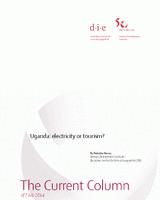Uganda: electricity or tourism?
Never, BabetteThe Current Column (2014)
Bonn: German Development Institute / Deutsches Institut für Entwicklungspolitik (DIE) (The Current Column of 7 July 2014)
Bonn, 7 July 2014. In the next few weeks, Uganda’s National Environmental Management Authority and the World Bank will decide on the size of the planned Isimba Falls hydropower plant on the White Nile. Negotiations take place behind closed doors. If it is built according to the originally proposed capacity of 183 megawatts (MW), Uganda and the World Bank will breach a 2007 agreement to conserve this stretch of the river. Adventure tourism in the region would be finished. If no dam – or a smaller one – is built, tourism can continue to exist and approximately 2,000 farmers can remain in their homes. But this would generate less electricity – which is urgently needed in Uganda. The situation in Uganda is showcasing the struggle to combine the often conflicting goals of environmental protection, energy and development that many African countries currently face. The only sensible compromise solution would be a smaller power plant.
Tourism and nature as sources of income
Tourism is key to the economic development of the Jinja region. The strong current of the White Nile offers unique conditions for whitewater rafting and kayaking, as well as for hydroelectric power plants. There are already two power plants in place: Owen Falls (with a capacity of 180 MW) and Bujagali Falls (250 MW). Adventure tourism has been booming for years, even though the rafting operators were forced to move further downstream, following the completion of the Bujagali dam in 2012. The interest group Save Adventure Tourism Uganda fears for the jobs in the region if the Isimba Falls project materialized as planned, as a high dam would render rafting impossible. The initiative is therefore advocating for a smaller power plant. Around 20,000 water sports tourists visit the region each year, generating a regional turnover of around 4 million USD. Weekend guests and nature lovers hoping for a glimpse of the endangered grey crowned crane come on top of that. Tourism accounts for 5.6% of gross domestic product in Uganda. Although few tourists come to Uganda exclusively for the Jinja region, the activities available and the gorilla treks in the south make Uganda a unique destination compared to its competitors Kenya, Rwanda and Tanzania. Uganda has thereby taken a key step from an agricultural economy towards a diversified economy including service industries.
Pressure to act on energy policy
On the other side of the fence is the Ministry of Energy and Minerals Development. It has to provide more citizens with access to electricity and to deliver a stable supply of energy to businesses. To date, only 15% of Ugandans have access to electricity. Frequent power cuts affect the production and competitiveness of companies, particularly in the north and in rural areas. Solar energy and biomass power plants offer alternatives as off-grid solutions, i.e. they also function without being connected to the national electricity grid. In spite of globally falling construction costs, their expansion thus far has been slow and is still frequently dependent on international development funding. The growing energy requirements of industry can scarcely be covered by this – demand is growing at an annual rate of around 10-15%. “If the costs per unit for solar energy goes down, then solar energy will be the solution”, said President Yoweri Museveni in his state of the nation address on 5 June 2014. Until then, it is necessary to exploit all hydropower sites available. In the mid-term, the ministry of energy is therefore focusing on further large projects in this field such as the Karuma Falls power plant (600 MW) on the Victoria Nile.
It is hard to avoid the impression that the government is too hasty in collaborating with private foreign investors. In recent years, President Museveni has intervened in bidding processes on several occasions. He deemed the pace of progress of these large-scale projects too slow. The notorious tardiness of the authorities responsible in the drawing-up and granting of the necessary environmental and social impact assessments encourages many bidders to circumvent the requirements. This undermines the trust of all concerned in achieving a fair solution.
The conflict between energy and nature also exists in other areas in Uganda. Oil has been found in both the Murchison Falls National Park and in the Albertine Rift Valley. Drilling in the park allegedly has no effect on the animal population. Only recently, a British company abandoned plans to begin drilling in Virunga National Park on the Congolese side of the rift, facing massive international protest. Socially and ecologically compatible compromise solutions will only be acceptable to the Ugandan government if conservation and tourism generate sufficient local incomes. And if the international community is prepared to support compensation schemes that secure the future of the national park and reward the forgoing of the oil. The establishment of sustainable energy systems should neither be an isolated national exercise, nor should it occur without mutual learning by the global north and south.

